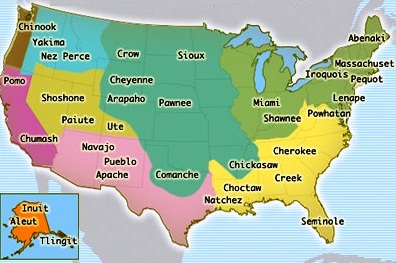Cheyenne Land
The Cheyenne Native Americans lived in harmony with the land which was emphasized by the their culture, religion and beliefs. The idea of an individual person having exclusive use of a particular piece of land was completely alien to Native Americans.
Cheyenne Land - Ownership?
The Cheyenne fought, as communities, with other tribes over hunting rights to their territory. But the "right" to the land was very different from the legal terms understood by the white settlers relating to individual ownership. The Cheyenne Indians had no concept of "private property," as applied to the land, but were soon to experience this European idea, through the constant encroachment on the tribal territories and Cheyenne land. In 1832 the tribe split up into the Northern and Southern Cheyenne.
Cheyenne Land - Wars and Conflicts
The American Indian Wars is the name used in the United States to describe a series of wars, battles and conflicts between American settlers or the U.S. army, and the Native American Indians before and after the American Revolutionary War. In 1851 settlers began seizing the lands of the Cheyenne. A Treaty was signed with the Cheyenne in 1861 and the Cheyenne agreed to live on a reservation in SE Colorado, but the U.S. government did not fulfil its obligations, and they were reduced to near starvation leading to bitter conflicts including the Sand Creek Massacre in 1864 when Colonel John Chivington and his Colorado Volunteers massacred Cheyenne and Arapaho men, women, and children. Battle of Beecher Island was a conflict between the United States Army and several of the Plains native American tribes, including the Cheyenne Indians in 1868.
The Battle of Summit Springs was the final military engagement between whites and plains Indians, including the Cheyenne in Colorado. The Sioux and the Cheyenne joined forces and fought in the Battle of Little Bighorn in 1876 against General George Armstrong Custer.
Cheyenne Land - Moved to the Reservation
Cheyenne resistance was broken in 1877, and the survivors confined to reservations in Oklahoma. Plagued by disease and malnutrition, the Cheyenne made two desperate attempts to escape and return to the north. A separate reservation was eventually established for them in Montana.
Cheyenne Land - Dawes General Allotment Act
The Dawes General Allotment Act was passed by Congress in 1887 which led to the break up of the large Indian Reservations and the sale of Indian lands, including Cheyenne lands to white settlers.

Cheyenne Land - Tribe Location Map |
Cheyenne Land - Tribal Map
The Tribe location map provides a general overview of the tribal territories and land inhabited by various tribes of Native Indians.
The Tribe Location Map provides a bird's eye view of the most famous Native American Indian groups and their proximately to other Native American tribes and their tribal territories.
The Cheyenne Native Indians, together with the other Native American tribes, were removed from their land and sent to inhospitable reservations.
They waited until 1969 when all Indians were declared citizens of the U.S.
Cheyenne Land
- Interesting Facts and information about Cheyenne Land
- Cheyenne Land Ownership
- Maps and interesting info
- Lands & Tribal territories
- Cheyenne Lands - Map
- Cheyenne Reservation
Pictures and Videos of Native American Indians
Cheyenne Land. Discover the vast selection of pictures and videos of Native Indians. The pictures show the clothing, weapons and decorations that can be used as a really useful educational resource for kids and children of all ages. Our series of videos enable fast access to the images, pics, paintings and pictures together with information and many facts. We hope that this article on Cheyenne Land will assist in your studies or homework and that you will enjoy watching the videos featuring many pictures of the Native Indians. A great educational resource for kids on the subject of Native American Indians including the Cheyenne tribe.